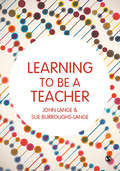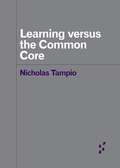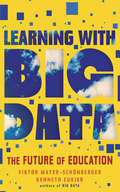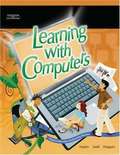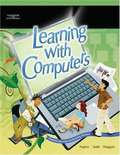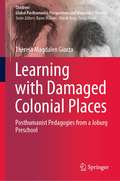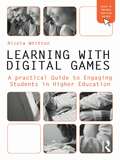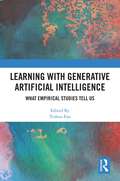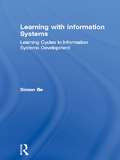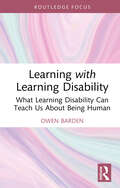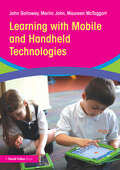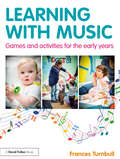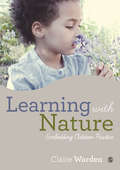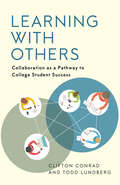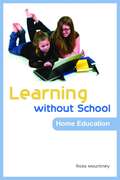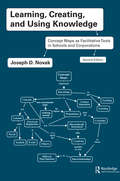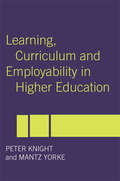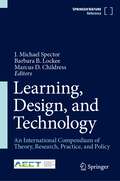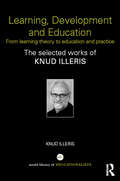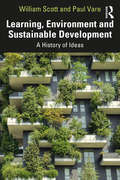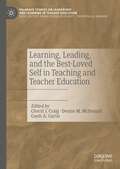- Table View
- List View
Learning to be a Teacher
by John Lange Sue Burroughs-LangeBeing a successful teacher means constantly examining your own development to identify blind spots and ensure you engage on a meaningful level with teaching and learning. This book discusses theoretical and conceptual ideas, linked to direct strategies for the classroom, that guide students towards becoming proactive and effective learners, giving them the confidence to take charge of their professional future in teaching. Built around a series of ‘contributing ideas', this book includes a conceptual framework for critically analysing and thinking about the teaching and learning environment. Examples throughout explore how to make the most of professional learning opportunities so students can take personal control of their learning, through self-regulation and self-monitoring. Strategies for making practical use of these ideas for classroom planning and preparation for learning are also included.
Learning to be a Teacher
by John Lange Sue Burroughs-LangeBeing a successful teacher means constantly examining your own development to identify blind spots and ensure you engage on a meaningful level with teaching and learning. This book discusses theoretical and conceptual ideas, linked to direct strategies for the classroom, that guide students towards becoming proactive and effective learners, giving them the confidence to take charge of their professional future in teaching. Built around a series of ‘contributing ideas′, this book includes a conceptual framework for critically analysing and thinking about the teaching and learning environment. Examples throughout explore how to make the most of professional learning opportunities so students can take personal control of their learning, through self-regulation and self-monitoring. Strategies for making practical use of these ideas for classroom planning and preparation for learning are also included.
Learning versus the Common Core (Forerunners: Ideas First #55)
by Nicholas TampioAn open challenge to Common Core&’s drive for uniformity Nicholas Tampio watched as his kindergartner&’s class shifted from one where teachers, aides, parents, and students worked hard to create a rewarding educational experience to one in which teachers delivered hours-long lectures using packaged lesson plans. Learning versus the Common Core explains how standards-based education reform is transforming nearly every aspect of public education by looking closely at the standards, the agenda of people pushing standards-based reform, and how these fit within a global pattern of education reform. With a nod to the philosophy of John Dewey, Tampio concludes with a vision of what democratic education can look like today—and how people can form rhizomatic alliances across different political and ethical backgrounds to fight the Common Core.Forerunners: Ideas First Short books of thought-in-process scholarship, where intense analysis, questioning, and speculation take the lead
Learning with Big Data
by Viktor Mayer-Schönberger Kenneth CukierHomework assignments that learn from students. Courses tailored to fit individual pupils. Textbooks that talk back. This is tomorrow's education landscape, thanks to the power of big data. These advances go beyond the much-discussed rise of online courses. As the New York Times-bestselling authors of Big Data explain, the truly fascinating changes are actually occurring in how we measure students' progress and how we can use that data to improve education for everyone, in real time, both on- and offline. Learning with Big Data offers an eye-opening, insight-packed tour through these new trends, for educators, administrators, and readers interested in the latest developments in business and technology.
Learning with Computers
by H. Albert Napier Jack P. Hoggatt Philip J. JuddThe new LEARNING WITH COMPUTERS LEVEL 8 Orange extends the original LEARNING WITH COMPUTERS LEVELS K-5 into middle school along with the new LEVEL 6 Blue and LEVEL 7 Green. The LEARNING WITH COMPUTERS series for middle school students delivers a strong foundation in keyboarding and computer applications. In this new project based text, students are introduced to the Explorers Club where three young members of the club - Luis, Ray, and Julie - guide students on virtual explorations. Along the way, each student keeps a personal journal about their explorations. The text offers multiple opportunities to reinforce and maintain basic keyboarding, word processing, spreadsheet, presentation, database, graphics, and Internet skills. Students are also introduced to new grade-level appropriate computer skills based on the National Educational Technology Standards (NETS). Additionally, the text emphasizes research, reading, and writing activities relevant to social studies, science, math, and language arts curriculum. The text for use with Windows applications, is divided into 4 units; Word Processing, Spreadsheets, Presentations (Graphics, Multimedia, and Integration) and Databases. Each unit contains multiple projects for a total of 18 projects per text, plus an introductory project. Each project focuses on a group of grade-level appropriate objectives for particular computer applications. Several hands-on activities within each project are designed around these objectives. Additionally, students use multiple application tools such as keyboard shortcuts, shortcut menus, toolbars, and the menu bar to perform tasks. This one-semester text can be used as a stand alone or in conjunction with South-Western's MicroType keyboarding software. MicroType is an engaging, easy-to-use program that teaches new-key learning and skill building. Features include 3-D animations, videos, and fun interactive games.
Learning with Computers
by H. Albert Napier Jack P. Hoggatt Philip J. JuddThe new LEARNING WITH COMPUTERS LEVEL 7 Green extends the original LEARNING WITH COMPUTERS LEVELS K-5 into middle school along with the new LEVEL 6 Blue and LEVEL 8 Orange. The LEARNING WITH COMPUTERS series for middle school students delivers a strong foundation in keyboarding and computer applications. In this new project based text, students are introduced to the Explorers Club where three young members of the club - Luis, Ray, and Julie - guide students on virtual explorations. Along the way, each student keeps a personal journal about their explorations. The text offers multiple opportunities to reinforce and maintain basic keyboarding, word processing, spreadsheet, presentation, database, graphics, and Internet skills. Students are also introduced to new grade-level appropriate computer skills based on the National Educational Technology Standards (NETS). Additionally, the text emphasizes research, reading, and writing activities relevant to social studies, science, math, and language arts curriculum. The text for use with Windows applications, is divided into 4 units; Word Processing, Spreadsheets, Presentations (Graphics, Multimedia, and Integration) and Databases. Each unit contains multiple projects for a total of 18 projects per text, plus an introductory project. Each project focuses on a group of grade-level appropriate objectives for particular computer applications. Several hands-on activities within each project are designed around these objectives. Additionally, students use multiple application tools such as keyboard shortcuts, shortcut menus, toolbars, and the menu bar to perform tasks. This one-semester text can be used as a stand alone or in conjunction with South-Western's MicroType keyboarding software. MicroType is an engaging, easy-to-use program that teaches new-key learning and skill building. Features include 3-D animations, videos, and fun interactive games.
Learning with Damaged Colonial Places: Posthumanist Pedagogies from a Joburg Preschool (Children: Global Posthumanist Perspectives and Materialist Theories)
by Theresa Magdalen GiorzaThis book offers a close and detailed account of the emergent and creative pedagogies of children learning together in a small, not-for-profit preschool, and the entangled becomings of their carers as well as the researcher–artist–author. The mutually affecting and inseparable realities of the ‘material’ and the ‘discursive’ are made visible through lively and sensual pedagogical invention by a group of five-year olds in the inner-city preschool which is located in Johannesburg, South Africa. These small, local stories are recognized in their emergence with global geopolitical realities. The author makes a valuable contribution to post-qualitative research through the use of visual research methods and non-representational approaches to working with knowledge. The book draws on the constantly evolving practices of Philosophy for Children (P4C) and Reggio Emilia both as pedagogical tools and as research methods. Photographs and stills from video footage provide a sense of the relatively modest material environment of the school. The book celebrates the considerable richness of the involvement of the children and the enormous possibilities offered by the world both inside and outside of the classroom when an enquiry-led art-based pedagogy is followed. Drawings and other products created by the children in the study offer valuable insight into the depth and complexity of their engagement with their worlds, both individual and collaborative.
Learning with Digital Games: A Practical Guide to Engaging Students in Higher Education (Open and Flexible Learning Series)
by Nicola WhittonWritten for Higher Education teaching and learning professionals, Learning with Digital Games provides an accessible, straightforward introduction to the field of computer game-based learning. Up to date with current trends and the changing learning needs of today’s students, this text offers friendly guidance, and is unique in its focus on post-school education and its pragmatic view of the use of computer games with adults. Learning with Digital Games enables readers to quickly grasp practical and technological concepts, using examples that can easily be applied to their own teaching. The book assumes no prior technical knowledge but guides the reader step-by-step through the theoretical, practical and technical considerations of using digital games for learning. Activities throughout guide the reader through the process of designing a game for their own practice, and the book also offers: A toolkit of guidelines, templates and checklists. Concrete examples of different types of game-based learning using six case studies. Examples of games that show active and experiential learning Practical examples of educational game design and development. This professional guide upholds the sound reputation of the Open and Flexible Learning series, is grounded in theory and closely links examples from practice. Higher Education academics, e-learning practitioners, developers and training professionals at all technical skill levels and experience will find this text is the perfect resource for explaining "how to" integrate computer games into their teaching practice. A companion website is available and provides up-to-date technological information, additional resources and further examples.
Learning with Generative Artificial Intelligence: What Empirical Studies Tell Us
by Yizhou FanThis book delves into the core of education’s digital transformation, presenting a thorough and empirical examination of generative artificial intelligence (GenAI)’s impact beyond the theoretical and fragmented insights prevalent in current discourse.Drawing from peer-reviewed and extensive empirical studies, the contributors aim to unveil the multifaceted effects of GenAI (particularly ChatGPT) on learning. They navigate through topics of interaction, assessment, emotion, effect and efficiency, meta-cognition, and ethics, offering a comprehensive exploration of GenAI’s educational implications. This book presents a closed loop of learning theory, multimodal data, and learning analytics technology. Furthermore, this book builds and proposes core conceptual models for future learning and identifies potential research directions.This book will serve as a foundational reference for educators seeking innovative learning and teaching methods and for researchers and technologists who seek to push the boundaries of educational technology and related areas.
Learning with Information Systems: Learning Cycles in Information Systems Development (Routledge Research in Information Systems)
by Simon BellIn Learning with Information Systems the author takes the developing world as the context and through a series of case studies develops a commonly used systems analysis methodology. He demonstrates how this methodology can evolve and adapt as new ideas become prominent. Issues of sustainability of information systems, participation in systems design and user ownership of systems are all examined. This book does not attempt to be prescriptive for all contexts nor does it focus on any particular technology. It addresses the essential questions and promises practical approaches which will help in the avoidance of the worst forms of disaster associated with the planning of information systems for developing countries.
Learning with Learning Disability: What Learning Disability Can Teach Us About Being Human (Autocritical Disability Studies)
by Owen BardenThis book uses the concept of “learning disability” to explore what it means to be human. It argues that we need to learn with rather than from or about learning disability. This crucial distinction means being open to what learning disability can teach us about what it means to be human. This approach comes from recognising learning disability as an organising concept – a concept which radically transforms our sense of what it means to be – or not be – a person.After reflecting on the author’s relationship to learning disability, the book explores relationships and tensions between conceptualisations of learning disability and of the human. Through historical ontology, the book initially examines how the phenomenon of “learning disability” came into being. It then explores ways in which the concept of learning disability has, over the course of the 20th and 21st centuries, radically transformed our sense not only of education and learning, but also of who is or is not deemed entitled to full citizenship and the associated rights, and so who is or is not fully human. Each chapter of the book exposes tensions and contradictions apparent in the ways we tend to think about personhood and learning disability, illuminating them through a series a binary oppositions: human and not fully human; menacing and vulnerable; controlled and abandoned; capable and incapable; human and posthuman.The book concludes by drawing together these tensions and contradictions to challenge the prevailing metanarrative of disability and make the case for a more inclusive conceptualisation of what it means to be human.It will be of interest to all scholars and students of disability studies, the history of learning disability, humanism and posthumanism, and learning disability advocacy.
Learning with Mobile and Handheld Technologies: Inside And Outside The Classroom
by John Galloway Merlin John Maureen McTaggartAs technology evolves we are ever more reliant on the use of handheld and mobile devices, yet what do we know about their impact on learning? While there is a lot of interest in mobile technology, many schools still aren’t sure how to best use it for learning and teaching. Learning with Handhelds and Mobiles explores this landscape and offers examples of how these technologies have been used for learning, how the problems that have arisen are being addressed, and offers ideas for the future. This invaluable book gives a voice to teachers and educators using mobiles and technology-enhanced learning in and out of schools, for regular school work and for innovative projects through exciting partnerships like Apps for Good. Learning with Handhelds and Mobiles shows the changes that are taking place within schools as a direct result of these emerging technologies, and contains case studies with accounts of best practice in a variety of settings including primary, secondary, and special schools, and learning beyond their boundaries. The book also explores themes of pedagogy, communication and affordances, collaborative learning, individual creativity and expression, self-directed and informal learning and outdoor education. The learning potential of handheld and mobile devices has excited teachers and educators, but until now there has been no structured, systematic overview available along with reflections on how this technology is changing educational practice. This book brings these together to provide a clearer picture of what is currently a fragmented area, and offers expert views of how we can understand these, and where it may take us next.
Learning with Music: Games and Activities for the Early Years
by Frances TurnbullLearning with Music offers an accessible introduction to music education theory for those working in the early years. Using real case studies and rich examples, the book provides practical suggestions to develop the formative ideas of music education, such as melody, rhythm, pulse and timbre, into games and activities for every early years setting. Chapters include a range of tried-and-tested lesson sequences and accompanying developmental benefits, allowing practitioners to confidently create tailor-made lesson plans and manage music sessions, ranging from one child through to larger groups. Each concept is grounded in child development theory, as well as music education theory, giving practitioners an insight into the research-based principles and priorities of music education for their own unique setting. With a clear focus on the benefits of teaching music from birth to preschool, Learning with Music is essential reading for all early years practitioners, as well as students on Early Childhood courses.
Learning with Nature: Embedding Outdoor Practice
by Ms Claire Helen WardenLearning outside the classroom is a key part of early years and primary practice and is on the rise in settings across the world. This book centres on outstanding outdoor practice and how children can learn and develop in natural environments. Focussing on children aged from 2-11 this book contains: A self-evaluation toolkit for educators to reflect on what they’re doing now and where to develop to be more effective. Examples of practice from around the world and in various environments, including urban settings. An entire chapter on assessment and planning to help ensure and demonstrate quality of provision. Looking at all the possibilities and approaches, there are models for practice to suit every setting so that everyone can make outdoor learning part of the core teaching and learning objectives. Claire Warden is an educational consultant with an international reputation for pioneering work in education and a focus on children’s connection to the natural world. For more details of her work visit www.claire-warden.com
Learning with Nature: Embedding Outdoor Practice
by Ms Claire Helen WardenLearning outside the classroom is a key part of early years and primary practice and is on the rise in settings across the world. This book centres on outstanding outdoor practice and how children can learn and develop in natural environments. Focussing on children aged from 2-11 this book contains: A self-evaluation toolkit for educators to reflect on what they're doing now and where to develop to be more effective. Examples of practice from around the world and in various environments, including urban settings. An entire chapter on assessment and planning to help ensure and demonstrate quality of provision. Looking at all the possibilities and approaches, there are models for practice to suit every setting so that everyone can make outdoor learning part of the core teaching and learning objectives. Claire Warden is an educational consultant with an international reputation for pioneering work in education and a focus on children's connection to the natural world. For more details of her work visit www.claire-warden.com
Learning with Online and Mobile Technologies: A Student Survival Guide
by Janet MacDonald Linda CreanorTechnology has become a necessary and everyday part of studying. This book starts with effective practice in learning, and shows how technology can support that good practice. The authors show you the many ways in which online and mobile technologies can be used for study and give you guidance on how best to use them for learning in higher education, whether that is at college or university, or within your workplace. This wide-ranging survival guide combines advice on effective learning, with practical tips on using technology successfully to give you a smart approach to accessing, recording, sharing and revising information and knowledge. An efficient learning strategy with technologies will help you develop independence and self direction, so that when faced with a bewildering choice of web-based resources you are confident about how much to read, and when to stop. The approaches, skills and techniques discussed in this book will be of value to you not only in your formal course of study, but also in any other learning you might wish to undertake in future. In an increasingly competitive job market this will also be attractive to prospective employers.
Learning with Others: Collaboration as a Pathway to College Student Success
by Clifton Conrad Todd LundbergHow can colleges and universities engage students in ways that prepare them to solve problems in our rapidly changing world?Most American colleges and universities assimilate students into highly competitive undergraduate experiences. By placing achievement for personal and material gain as the bedrock of a college education, these institutions fail to educate students to become collaborative learners: people who are committed and prepared to join with others in developing promising solutions to problems that they share with others. Drawing on a three-year study of student persistence and learning at Minority-Serving Institutions, Clifton Conrad and Todd Lundberg argue that student success in college should be redefined by focusing on the importance of collaborative learning over individual achievement. Engaging students in shared, real-world problem-solving, Conrad and Lundberg assert, will encourage them to embrace interdependence and to value and draw on diverse perspectives. Learning with Others presents a set of core practices to empower students to enter, nourish, and sustain collaborative learning and outlines how to blend the roles and responsibilities of faculty, staff, and students; how to adopt best practices for receiving and giving feedback on problem-solving; and how to anchor a curriculum in shared problem-solving.Bringing together lessons learned from more than 300 interviews, along with notes from 14 campus visits, 3 national convenings, and examples from across our nation's colleges and universities, Conrad and Lundberg explore ways in which successful antiracist networks of problem-solvers are learning to contribute to the flourishing of their communities on campus and far beyond. Outlining strategies for identifying and dismantling barriers to participation, Learning with Others will pique interest among faculty, students, and administrators in higher education and a wide range of external stakeholders—from families and communities to policymakers and funders.Clifton Conrad and Todd Lundberg
Learning without School: Home Education
by Ross MountneyWhile some people look back on school as the 'best days of your life', for others the experience can be unpleasant and gruelling. Learning without School is a practical handbook for parents who want to educate their children at home but are unsure that they have the skills and know-how required to give their child the best education possible. This book explains what home education is; the advantages and disadvantages of choosing this route; how to begin home educating; what you need to do and how to help your child adjust; and how home education affects children's social skills and friendships. It also covers technical aspects, such as the curriculum, core subjects, exams and timetables. Ross Mountney also considers children with 'learning difficulties' or 'special needs' and how to approach home education differently for this group of children. Each chapter contains a summary of key points, useful websites, hints and tips and real-life case studies. This practical guide offers indispensible support for parents who are considering home education for their child, and includes a broad philosophy of education that will interest all parents and professionals involved in education and child welfare.
Learning, 5th Edition
by A. Charles CataniaThe 5th Edition surveys the major areas in the psychology of learning from a consistent behavioral point of view. Learning explores the continuities between human learning and the learning of other animals. The book organizes the phenomena of learning in a systematic way, moving from Behavior Without Learning (evolution) to Learning Without Words (basics in nonhuman behavior and learning) to Learning With Words (human learning and memory).
Learning, Creating, and Using Knowledge: Concept Maps as Facilitative Tools in Schools and Corporations
by Joseph D. NovakThis fully revised and updated edition of Learning, Creating, and Using Knowledge recognizes that the future of economic well being in today's knowledge and information society rests upon the effectiveness of schools and corporations to empower their people to be more effective learners and knowledge creators. Novak’s pioneering theory of education presented in the first edition remains viable and useful. This new edition updates his theory for meaningful learning and autonomous knowledge building along with tools to make it operational ─ that is, concept maps, created with the use of CMapTools and the V diagram. The theory is easy to put into practice, since it includes resources to facilitate the process, especially concept maps, now optimised by CMapTools software. CMapTools software is highly intuitive and easy to use. People who have until now been reluctant to use the new technologies in their professional lives are will find this book particularly helpful. Learning, Creating, and Using Knowledge is essential reading for educators at all levels and corporate managers who seek to enhance worker productivity.
Learning, Curriculum and Employability in Higher Education
by Peter Knight Mantz YorkeHow can universities ensure that they are preparing their students for today's competitive job market?This book tackles the highly topical subject of graduate underemployment with insight and clarity. The authors argue the case for more sophisticated research into employability with passion and vision, discussing how employability-friendly curricula can be developed, even in subjects which have less obvious vocational relevance.The rapid growth of higher education over the past fifty years has seen expectations increase, and governments seeking to widen participation. There is now an urgent need for the Government and higher education institutions to address the issue of graduate employability. The authors of this timely book encourage a pro-active stance, offering a ground-breaking model that can be easily implemented in institutions to make low-cost, high-gain improvements to students' employability. Topics covered include:* The challenge of employability* The study and careers of English graduates* The enhancement of practice* Assessing employability* The Skills Plus project.Based on a set of over 200 in-depth interviews with recent graduates, this book forms a unique account of the meanings of employability in the workplace.
Learning, Design, and Technology: An International Compendium of Theory, Research, Practice, and Policy
by J. Michael Spector Barbara B. Lockee Marcus D. ChildressThe multiple, related fields encompassed by this Major Reference Work represent a convergence of issues and topics germane to the rapidly changing segments of knowledge and practice in educational communications and technology at all levels and around the globe. There is no other comparable work that is designed not only to gather vital, current, and evolving information and understandings in these knowledge segments but also to be updated on a continuing basis in order to keep pace with the rapid changes taking place in the relevant fields. The Handbook is composed of substantive (5,000 to 15,000 words), peer-reviewed entries that examine and explicate seminal facets of learning theory, research, and practice. It provides a broad range of relevant topics, including significant developments as well as innovative uses of technology that promote learning, performance, and instruction. This work is aimed at researchers, designers, developers, instructors, and other professional practitioners.
Learning, Development and Education: From learning theory to education and practice
by Knud IllerisIn the World Library of Educationalists, international experts themselves compile career-long collections of what they judge to be their finest pieces – extracts from books, key articles, salient research findings, major theoretical and practical contributions – so the world can read them in a single manageable volume. Readers will be able to follow the themes and strands and see how their work contributes to the development of the field. This volume brings together the selected works of Knud Illeris. Leaving a promising business career at age 27 to begin his higher education, Knud Illeris exemplifies the true spirit of youth and adult education that has resulted in him having published in almost twenty countries, including the UK, Germany, China, Korea and Brazil. Knud Illeris’ work revolves around the way learning takes place and in some cases does not take palce. Split into five parts; Learning Theory, Lifelong Learning as a Psychological Process, Special Learning Issues, Various Learning Approaches to Education, Learning in Working Life, Learning, Development and Education: From learning theory to education and practice is arranged thematically and examines youth and adult learning through Illeris’ model based on three dimensions of learning and competence development– emotional, cognitive and social, and four kinds of learning. In this collection of his papers, written over a period of almost five decades, and published in multiple languages, spanning from Faroese to Chinese, some of his most important works are chronicled. This compelling overview of Illeris’ contribution to educational thinking and theory charts the challenges and obstacles faced by disciplination and selection, and offers a genuine impression and understanding of an almost lifelong engagement with a wide range of topics in the field of learning – an engagement which has been the central area of Illeris’ academic life.
Learning, Environment and Sustainable Development: A History of Ideas
by William Scott Paul VareThis book is an introduction to the long history of human learning, the environment and sustainable development – about our struggles with the natural world: first for survival, then for dominance, currently for self-preservation, and in future perhaps, even for long-term, mutually beneficial co-existence. It charts the long arc of human–environment relationships through the specific lens of human learning, putting on record many of the people, ideas and events that have contributed, often unwittingly, to the global movement for sustainable development. Human learning has always had a focus on the environment. It’s something we’ve been engaged in ever since we began interacting with our surroundings and thinking about the impacts, outcomes and consequences of our actions and interactions. This unique story told by the authors is episodic rather than a connected, linear account; it probes, questions and re-examines familiar issues from novel perspectives, and looks ahead. The book is of particular interest to those studying (and teaching) courses with a focus on socio-economic and environmental sustainability, and non-governmental organisations whose work brings them face-to-face with the general public and social enterprises.
Learning, Leading, and the Best-Loved Self in Teaching and Teacher Education (Palgrave Studies on Leadership and Learning in Teacher Education)
by Cheryl J. Craig Gayle A. Curtis Denise M. McDonaldThis book explores the concept of the "best-loved self" in teaching and teacher education, asserting that the best-loved self is foundational to the development of teacher identity, growth in context, and learning in community. Drawing on the work of Joseph Schwab, who was the first to name the "best-loved self," the editors and their contributors extend this knowledge further through the collaboration of their group of teacher educators, known as the Faculty Academy, who have been involved in examining teacher education for over two decades.
